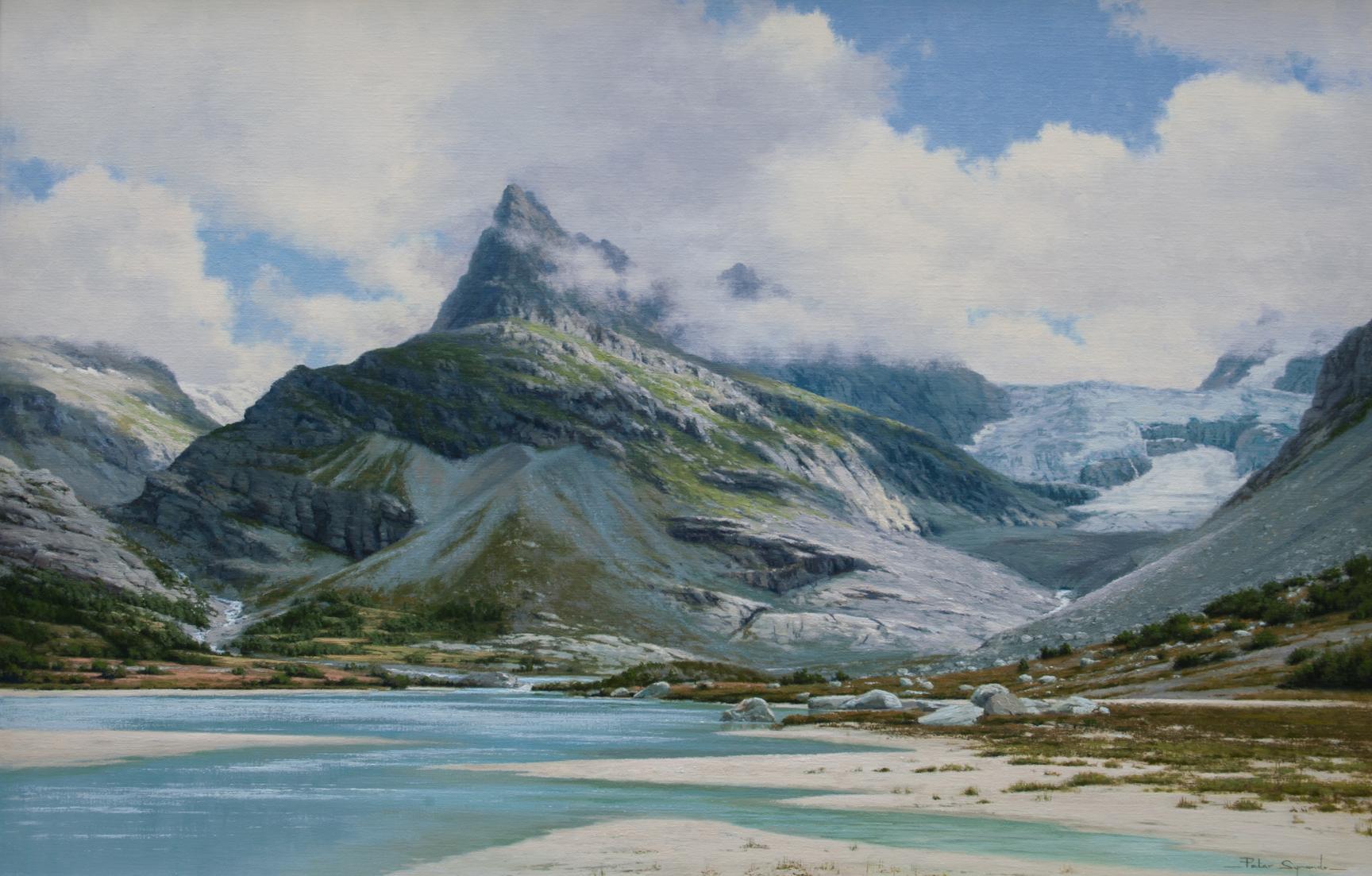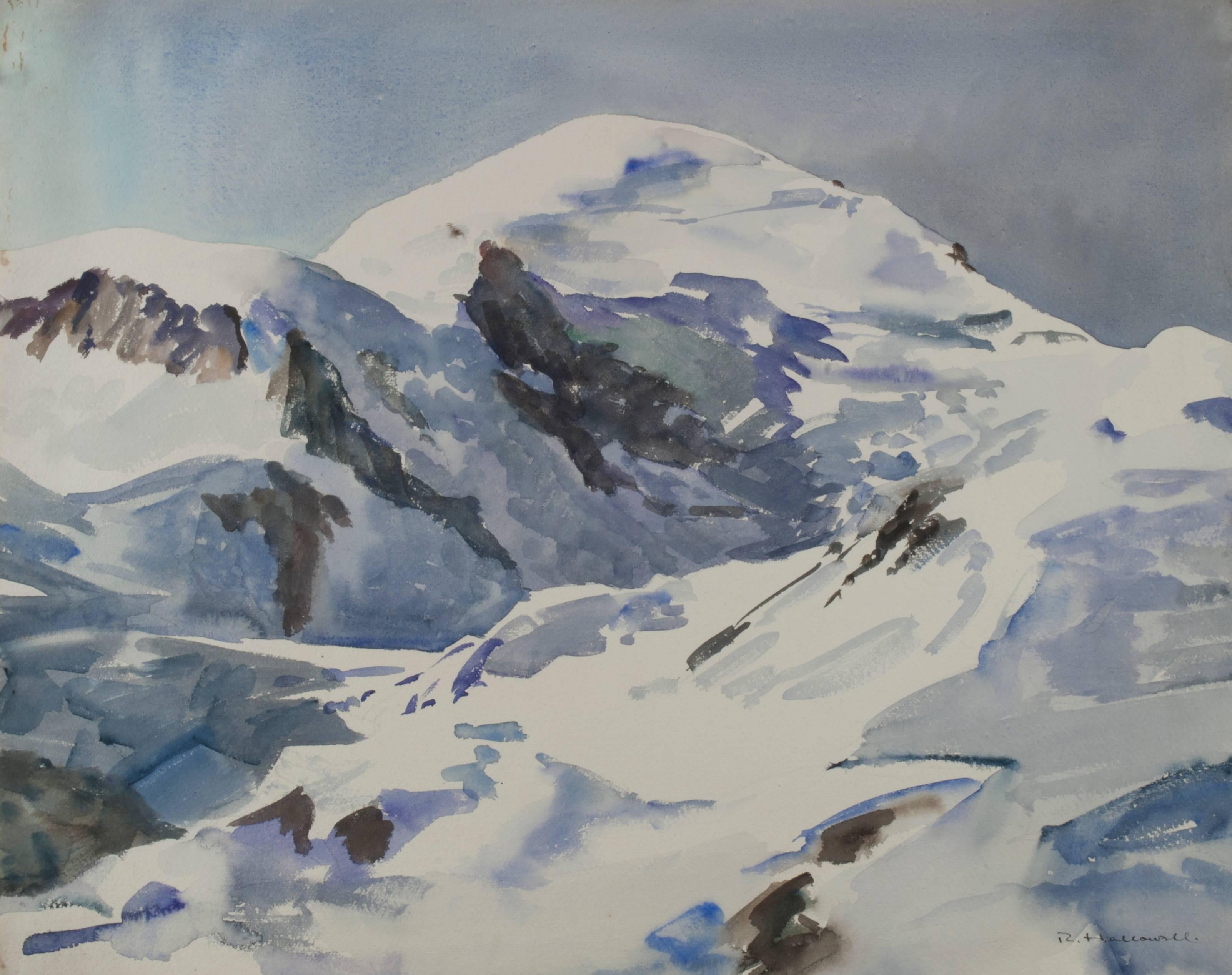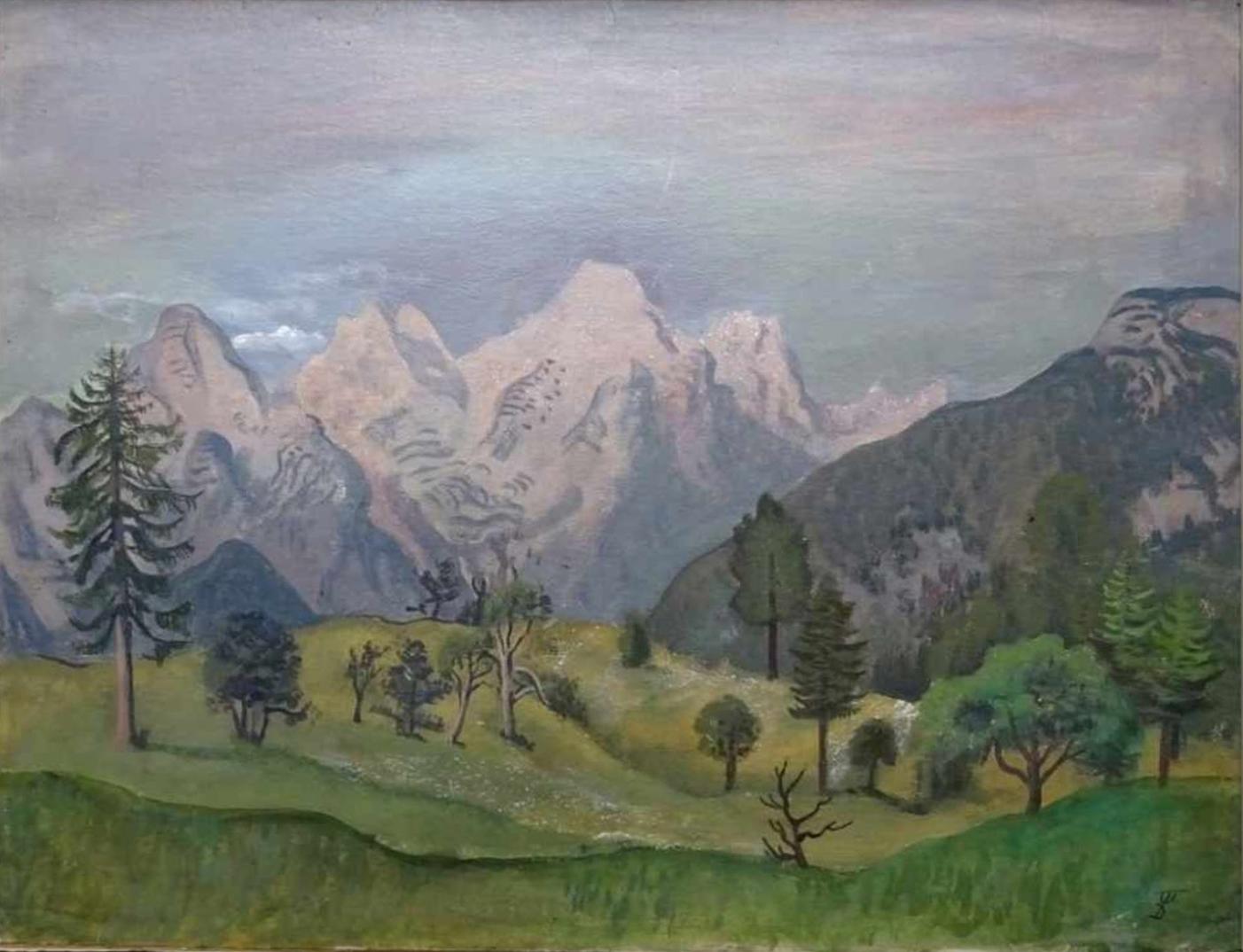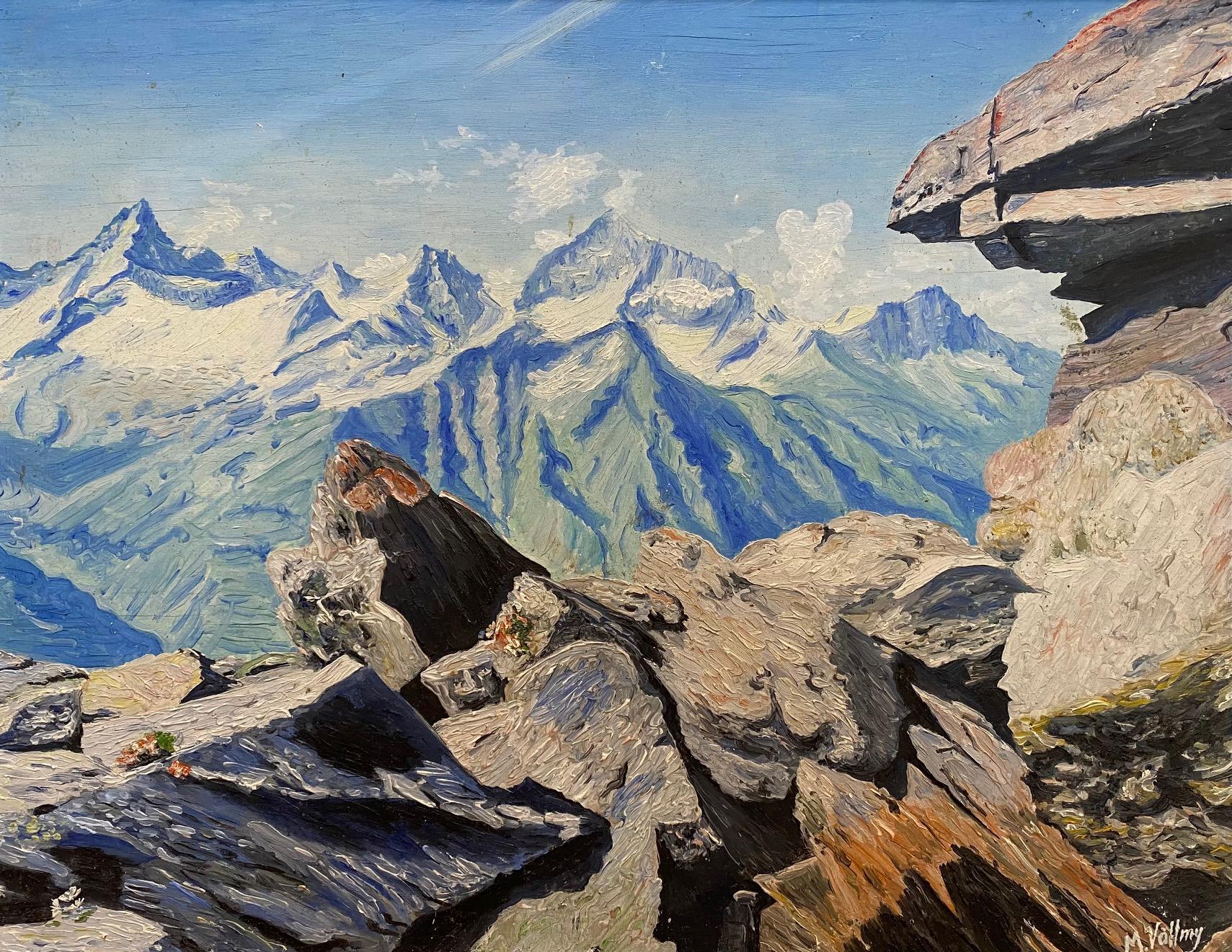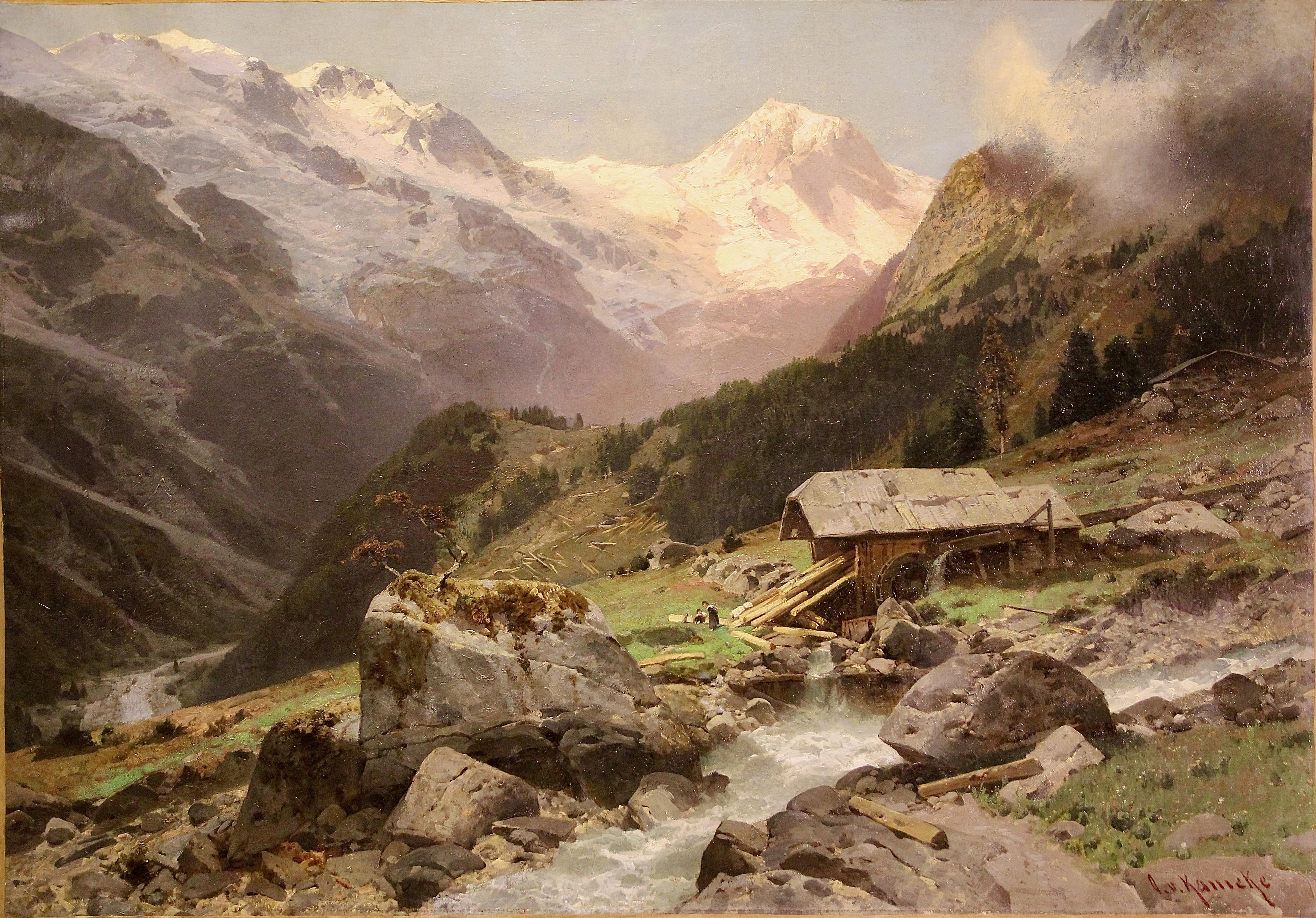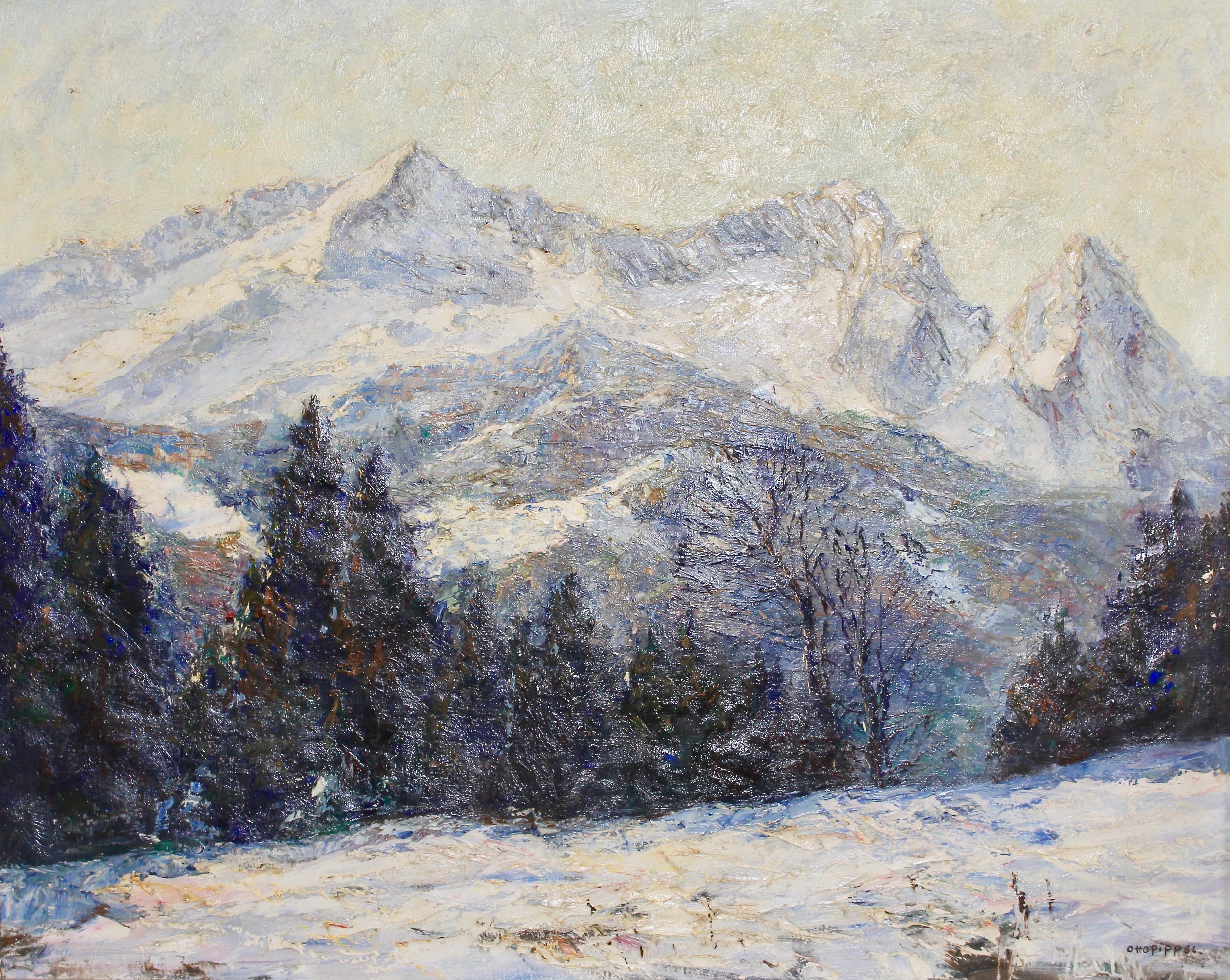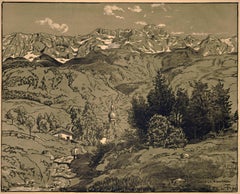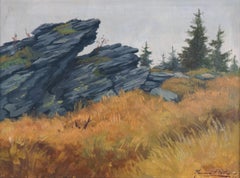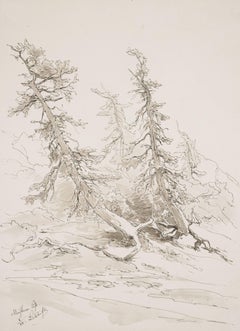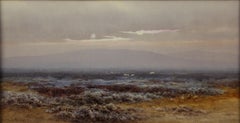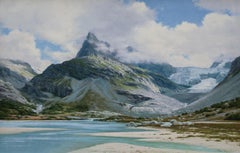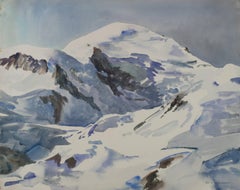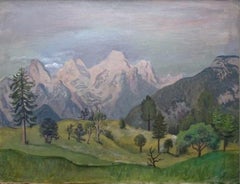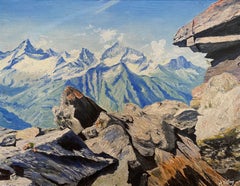Items Similar to Wettersteinkamm - The blue of the mountains -
Want more images or videos?
Request additional images or videos from the seller
1 of 8
Adalbert HolzerWettersteinkamm - The blue of the mountains -1923
1923
$911.38
$1,139.2220% Off
£677.97
£847.4620% Off
€760
€95020% Off
CA$1,247.99
CA$1,559.9820% Off
A$1,387.59
A$1,734.4920% Off
CHF 724.52
CHF 905.6520% Off
MX$16,890.35
MX$21,112.9420% Off
NOK 9,244.60
NOK 11,555.7520% Off
SEK 8,661.75
SEK 10,827.1820% Off
DKK 5,785.46
DKK 7,231.8320% Off
Shipping
Retrieving quote...The 1stDibs Promise:
Authenticity Guarantee,
Money-Back Guarantee,
24-Hour Cancellation
About the Item
Adalbert Holzer (1881 Munich - 1966 Munich). Wettersteinkamm. Watercolour, 29 x 34.5 cm (visible size), 37.5 x 43 cm (frame), signed and dated at lower right 'ADALBERT HOLZER [19]23'.
Framed behind glass. Frame shows signs of wear.
- The blue of the mountains -
About the artwork
The Wetterstein ridge is revealed to the viewer from a gentle, snow-covered hill. In contrast to conventional depictions of mountains, the painting is composed entirely of shades of blue, which condense into the blue-grey of the rock or fade into the white of the snow. As a complementary colour to the blue, Holzer virtuously activates the ochre ground. The uniform yet exciting polarity of the colours emphasises the massive majesty of the mountains and at the same time underlines the special character of the Wetterstein ridge. Holzer transferred the translucency of glass painting, in which he was originally trained, to watercolour and developed a pictorial language related to the art of Ferdinand Hodler, which earned him the nickname 'Master of Blue' and led to the appreciation of his watercolours in particular.
About the artist
After an apprenticeship as a stained glass painter at the Kunstgewerbeschule, Adalbert Holzer studied at the Munich Art Academy under Carl von Marr from 1904. Early on, however, Holzer was drawn to the mountains to paint. With his artist friend Otto Bauriedl, he repeatedly went into the mountains and mastered difficult ascents, such as the first ascent of the north face of the Spritzkar. From 1904, Holzer worked as a freelance artist, producing contributions inspired by Giovanni Segantini and Fritz Baer for the 'Jugend', the 'Jugendblätter' and the 'Leipziger Illustrierte'. Later he concentrated more and more on the mountain world and contributed pictures to the 'Deutsche Alpenzeitung', the 'Mitteilungen des Deutschen Alpenvereins' and the 'Bergkamarad'.
Holzer regularly took part in exhibitions at the Munich Glaspalast and, in 1912, at the Great Art Exhibition in Berlin.
"His ink, brush and pen drawings capture the mountain's personality with a few concise strokes, leaving room for artistic sensitivity. He achieves particular mastery in his watercolours and paintings in oil and tempera".
Josef Weingärtner
"A striking and outstanding strength of Holzer's is revealed in his ink drawings. Here every outline, every shadow is limited to the essential and characteristic, and no superfluous brushstroke detracts from the overall effect".
Fritz Schmitt
Selected Bibliography
Fritz Schmitt: Dem Bergmaler Adalbert Holzer zum Gedenken. In: Mitteilungen des Deutschen Alpenvereins 19,5 (September 1967), S. 123-124.
Erwin Georg Hipp: Adalbert Holzer. Maler der Berge und Bergsteiger, Leoni am Starnberger 2008.
GERMAN VERSION
Adalbert Holzer (1881 München - 1966 München). Wettersteinkamm. Aquarell, 29 x 34,5 cm (Sichtmaß), 37,5 x 43 cm (Rahmen), rechts unten signiert und datiert „ADALBERT HOLZER [19]23“.
Hinter Glas gerahmt. Rahmen mit Gebrauchsspuren.
- Das Blau der Berge -
zum Werk
Von einer sanften schneebedeckten Anhöhe aus offenbart sich dem Betrachter der Wettersteinkamm. Im Gegensatz zu konventionellen Gebirgsdarstellungen ist das Bild nur aus Blautönen aufgebaut, die sich zum Blaugrau des Felsgesteins verdichten oder zum Weiß des Schnees aufhellen. Als Komplementärfarbe zum Blau aktiviert Holzer auf virtuose Weise den ockerfarbenen Malgrund. Die einheitliche, aber dennoch in sich spannungsreiche Farbpolarität bringt die massive Majestät der Berge zum Aufleuchten und stellt dabei zugleich den besonderen Charakter des Wettersteinkamms heraus. Holzer hat das Durchscheinende der Glasmalerei, in der er ursprünglich ausgebildet worden war, ins Aquarell übertragen und eine der Kunst Ferdinand Hodlers verwandte Bildsprache entwickelt, die ihm den Beinamen ‚Meister des Blaus‘ eingetragen und zur Wertschätzung gerade seiner Aquarelle geführt hat.
zum Künstler
Nach einer Lehre als Glasmaler an der Kunstgewerbeschule studierte Adalbert Holzer ab 1904 an der Münchner Kunstakademie als Schüler Carl von Marrs. Schon früh zog es Holzer jedoch in die Berge, um dort zu malen. Mit seinem Künstlerfreund Otto Bauriedl ging er immer wieder ins Gebirge und bewältige schwierige Besteigungen, so den Erstdurchstieg der Spritzkar-Nordwand. Ab 1904 als freischaffender Künstler tätig, schuf Holzer an Giovanni Segantini und Fritz Baer inspirierte Beiträge für die ‚Jugend‘, die ‚Jugendblätter‘ und die ‚Leipziger Illustrierte‘. Später konzentrierte er sich zusehends auf die Bergwelt und lieferte unteren anderem für die ‚Deutsche Alpenzeitung‘, die ‚Mitteilungen des Deutschen Alpenvereins‘ und den ‚Bergkamarad‘ Bildbeiträge.
Holzer beteiligte sich regelmäßig an den Ausstellungen im Münchner Glaspalast und 1912 an der Große Kunst-Ausstellung in Berlin.
„Seine Tusch-, Pinsel- und Federzeichnungen erfassen mit einigen prägnanten Strichen den Berg in seiner jeweiligen Persönlichkeit und lassen dem künstlerischen Empfinden Raum. Besondere Meisterschaft erreicht er in den Aquarellen und in den mit Öl- und Temperafarben ausgeführten Gemälden.“
Josef Weingärtner
„Eine auffallende und überragende Stärke Holzers offenbart sich in seinen Tusche-Pinsel-Zeichnungen. Hier ist jeder Umriß, jeder Schattenauf das Wesentliche und Charakteristische beschränkt und kein überflüssiger Pinselstrich beeinträchtigt die Gesamtwirkung.“
Fritz Schmitt
Auswahlbibliographie
Fritz Schmitt: Dem Bergmaler Adalbert Holzer zum Gedenken. In: Mitteilungen des Deutschen Alpenvereins 19,5 (September 1967), S. 123-124.
Erwin Georg Hipp: Adalbert Holzer. Maler der Berge und Bergsteiger, Leoni am Starnberger 2008.
- Creator:Adalbert Holzer (1881 - 1966, German)
- Creation Year:1923
- Dimensions:Height: 11.42 in (29 cm)Width: 13.78 in (35 cm)Depth: 0.79 in (2 cm)
- Medium:
- Movement & Style:
- Period:
- Condition:
- Gallery Location:Berlin, DE
- Reference Number:1stDibs: LU2438212326362
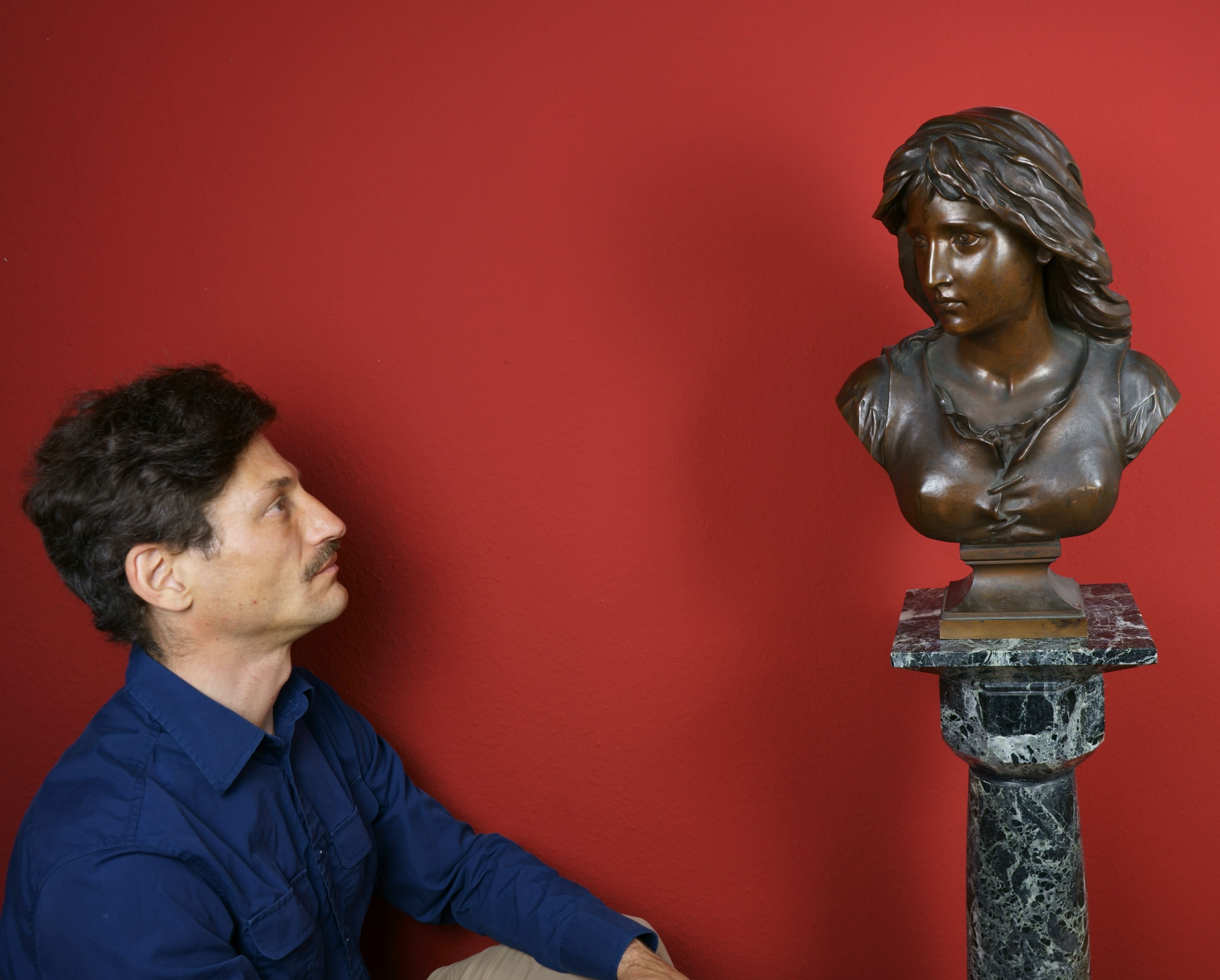
About the Seller
5.0
Gold Seller
Premium sellers maintaining a 4.3+ rating and 24-hour response times
Established in 2014
1stDibs seller since 2023
20 sales on 1stDibs
- ShippingRetrieving quote...Shipping from: Berlin, Germany
- Return Policy
Authenticity Guarantee
In the unlikely event there’s an issue with an item’s authenticity, contact us within 1 year for a full refund. DetailsMoney-Back Guarantee
If your item is not as described, is damaged in transit, or does not arrive, contact us within 7 days for a full refund. Details24-Hour Cancellation
You have a 24-hour grace period in which to reconsider your purchase, with no questions asked.Vetted Professional Sellers
Our world-class sellers must adhere to strict standards for service and quality, maintaining the integrity of our listings.Price-Match Guarantee
If you find that a seller listed the same item for a lower price elsewhere, we’ll match it.Trusted Global Delivery
Our best-in-class carrier network provides specialized shipping options worldwide, including custom delivery.More From This Seller
View AllS. Anton Patenkirchen / - The Home of the Landscape -
Located in Berlin, DE
Hans Thoma (1839 Bernau - 1924 Karlsruhe), S. Anton Patenkirchen, 1895. Algraph on strong wove paper, published by Breitkopf und Härtel in Leipzig as ‘Zeitgenössisches Kunstblatt Nr....
Category
1890s Realist Figurative Prints
Materials
Paper
Low Mountain Landscape with Rocks - The mystery of an inconspicuous place -
Located in Berlin, DE
Heinz Roder (1895-1965), Low Mountain Landscape with Rocks, oil on painting cardboard, 30 x 40 cm (visual size), 40 x 50 cm (frame), signed and dated "[19]34" at lower right. In a de...
Category
1930s Landscape Paintings
Materials
Cardboard
Woodland / - The Inner Drama of the Landscape -
Located in Berlin, DE
Eduard Peithner von Lichtenfels (1833 Vienna - 1913 Berlin), Woodland, 1884. Watercolor and pen and ink on drawing paper, 30.4 cm x 22.5 cm, signed, dated and inscribed by the artist...
Category
1880s Landscape Drawings and Watercolors
Materials
Paper
High Moorland Landscape in the fog - The world as a transcendent phenomenon -
Located in Berlin, DE
Charles Edward Brittan Jr (1870 Plymouth - 1949). High moor landscape in the fog. Gouache, signed at lower left "Charles E. Brittan", 18 x 34.5 cm (passepartout), 45 x 62 cm (frame)....
Category
Early 20th Century Realist Landscape Drawings and Watercolors
Materials
Watercolor
$1,726 Sale Price
20% Off
Impressionist Autumn Landscape with Lake / - Diffuse Concretion -
Located in Berlin, DE
Wilhelm Feldmann (1859 Lüneburg - 1932 Lübeck), Impressionist autumn landscape with lake, around 1905. Pastel on cardboard, 46 cm x 31 cm (inside dimension), 52 cm x 37 cm (frame), s...
Category
Early 1900s Impressionist Landscape Paintings
Materials
Gouache
Shady hollow way - Into the heart of the forest -
By Hans Dvoràk
Located in Berlin, DE
Hans Dvořák (19th century). Shady hollow way in a sunny forest. Watercolour and pen-and-ink drawing, 58.5 x 43 cm (visible size), 70 x 55.5 cm (frame), signed and dated "Hans Dvořák ...
Category
1880s Realist Landscape Drawings and Watercolors
Materials
Watercolor
$1,343 Sale Price
20% Off
You May Also Like
Mont Miné, Val d'Hérens, Swiss Alps
By Peter Symonds
Located in London, GB
Image dimensions: 66cm x 102cm
Framed dimensions: 81.5cm x 117.5cm
Signed lower right.
As one of Britains leading landscape artists, Peter Symonds is undeniably a master at captur...
Category
21st Century and Contemporary Contemporary Landscape Paintings
Materials
Canvas, Oil
Snowy Peaks (Mont Blanc)
By Robert Hallowell
Located in Fairlawn, OH
Snowy Peaks (Mont Blanc)
Watercolor on paper, c. 1930
Signed "R. Hallowell" lower right (see photo)
The image depicts is of Mont Blanc in France.
Mont Blanc is the highest mountain i...
Category
1930s American Impressionist Landscape Drawings and Watercolors
Materials
Watercolor
Salzburger Berge
By August Wilhelm Dressler
Located in Wien, 9
August Dressler is one of the painters of the New Objectivity. He is one of the lesser-known artists of the Weimar era, but he too, like his famous contemporaries Georg Grosz, John H...
Category
1930s Modern Landscape Drawings and Watercolors
Materials
Paper, Acrylic
Mountain's view by M. Völlmy - Oil on wood 40x50 cm
Located in Geneva, CH
Oil paint on wood with original frame.
Total size with frame: 60x50x5 cm
Category
1950s Academic Landscape Paintings
Materials
Oil
$720 Sale Price
20% Off
High Alpine Landscape, Alps. Oil Painting by Otto Werner Henning von Kameke.
Located in Berlin, DE
High Alpine Landscape, Alps. Oil Painting by Otto Werner Henning von Kameke.
Kameke was already a captain when he switched to art in 1860, went to Rome a...
Category
19th Century Landscape Paintings
Materials
Canvas, Oil
$8,634 Sale Price
20% Off
Free Shipping
Antique Painting, Oil on canvas, Winter Morning in the Alps Mountains, Zugspitze
Located in Berlin, DE
OTTO PIPPEL, Painting, Oil on canvas, Winter Morning in the Wetterstein Mountains, Zugspitze (Alps)
Beautiful, large painting by the internationally known artist Otto Pippel.
Snow...
Category
19th Century Realist Landscape Paintings
Materials
Canvas, Oil
$27,820 Sale Price
20% Off
More Ways To Browse
Mountain Drawing
German Mountain Landscape
Giovanni S Paintings
Dior Fur Hat
Weiss Artwork
Fritz Antiques
Blue Ridge Mountains Oil Painting
Segantini Giovanni
Bob Click
Charles De Wolf Brownell
Helen Allingham
Hugh Ferriss
Thomas Schaller
Worden Day
Arthur Severn
Augustus Spencer Paintings
E Ambrose Webster
Jane Lampard
